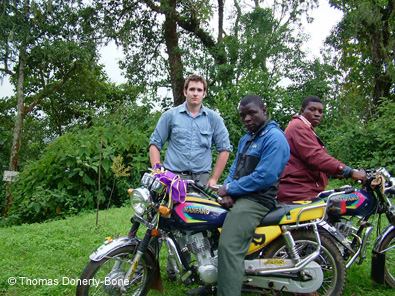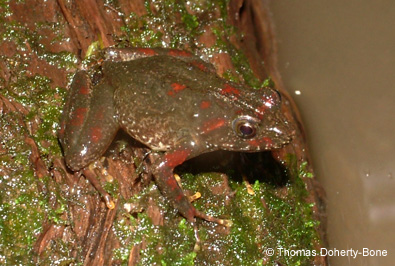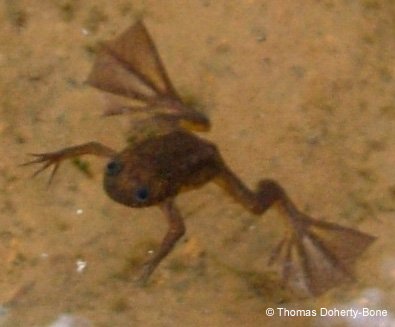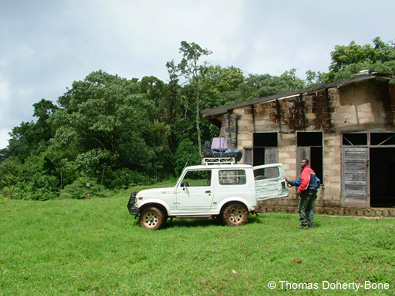Here is an update from Thomas Doherty-Bone, who is working in Cameroon on EDGE Amphibian number 34, the Lake Oku clawed frog.
Arrival in Cameroon
After a week in Yaoundé, meeting colleagues and processing permits at the Ministry of Wildlife and Forests, I took a bus to North West Province. While it was a 2 hour wait for it to leave Yaoundé, we went like a bat out of hell, arriving at Bamenda, the provincial capital in good time. Being met by my local guide at the bus station, our passage to the Oku community’s capital, Elak was interrupted by my collapsing in Kumbo with a simultaneous allergic reaction to bush crickets (we were later told these are collected using pesticide) and salmonella poisoning.
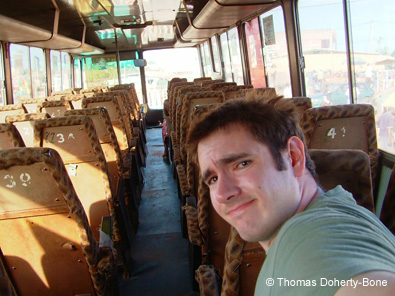
Two days and an intravenous drip later, we made our way to Elak-Oku, the centre for the Oku community. Meetings were held with the District Officer (local government representative) and mayor. Most importantly of all, we met with the Fon (king) of the Oku community. The latter is the most important figure as he is the traditional authority for the people and the Lake, and is arguably the most powerful authority in this region. After this, equipment was purchased and field staff mobilised for the upcoming project.
Recce and the Striking base camp
As the lake is a four hour walk from Elak, we made a reconnaissance trip to Lake Oku, to see about setting up a base camp. So we took a couple of motorbikes up the dirt road, into the Kilum Mountain Forest, to the lake. We found a good spot for pitching tents, by the old Baptist House in the forest, and then headed down the lake to see if we could see any frogs. Even our motorbike riders helped scour the lake’s shore for frogs, and showed a robust interest in their local biodiversity and the work being done. They even reminisced to us their high school biology lessons, and what they had learned about frogs themselves.
We found many Phrynobatrachus puddle frogs, but not many of our target species (you remember, the Lake Oku Clawed Frog Xenopus longipes). In fact, of the few we did find, these were all dead or dying, just like two years before. We were therefore not too late to catch the frogs should they be on the path to imminent extinction.
Local Liaisons
As with any visit to the lands of the Oku people, paying respects to the Fon and the palace was in order. The Fon of Oku is the absolute ruler of this land, and is the landlord for the Kilum Forest. Similarly, if one were to work on the other side of the mountain in the Ijim forest, one would be expected to pay a visit to the Fon of Kom. The Fon had been presented with the proposal for our work earlier in the year, so was already familiar with why we were there. Understanding the importance of this work, His Excellency felt it appropriate to provide the project co-ordinator with a traditional title.
So, I have been bestowed the title of Fai Mawes, meaning “notable of the Lake”. In an official ceremony, I was dressed up (like a Christmas tree) in traditional robes, sat down with other Fai (notables), then asked to present myself, and the upcoming project. Many of the people there were surprised to learn the biological importance of the Mawes, and showed immense interest in the work to be carried out. Many of the Oku people I talk to did not realise that the frog living in their spiritual resting place is endemic to that lake. Awareness is therefore a task left undone with regards the Lake Oku Clawed Frog (or maybe we should be calling it Frog of the Mawes). This shall be remedied with a notice board on the lake, for which we are still trying to secure funding.
The Study – First Impressions
We have hit off the research well, setting traps at different parts of the lake, and taking measurements on the water each morning. Oscar Ndifon, the junior field assistant is an apt chemist, and is taking to environmental chemistry with great zest. My local assistants and cook have grown up in and around the mountain forest, and love being here. They have spent their childhoods in the forest: herding goats; gathering honey and herbal medicine; collecting firewood; and hunting. They are also very keen to see the results of the work, and to help conserve the biodiversity of the lake and the forest. They are very understanding and obliging about disinfecting their boots and equipment, to mitigate the spread of infectious diseases between frog populations. In fact, being Oku men, they see it as some other version of cleansing ritual that they often perform as part of their culture.
The people of Oku still have a great love and respect for their forest, and try to resist pressures to develop at its expense. The lake is still surrounded by a thick blanket of forest. Pressures are however mounting, and these will be discussed in the next blog, along with highlights of the field work.
Read Thomas’ previous blogs on this research: Conservation Research: Lake Oku Clawed Frog and Introducing The Lake Oku Clawed Frog.
